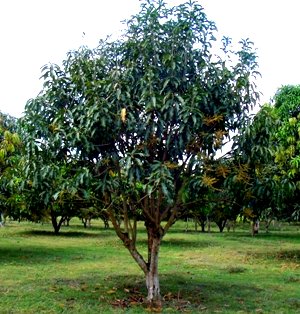Mature mango leaves are essential for a successful chemical floral induction particularly in the Mangifera indica (commonly known as Philippine Carabao Mango).
By “mature” it means most leaves should have a dark-green to bronze-green color.
When crushed by hand there’s that crispy or crunchy sound like that when eating toasted bread as if the leaf blades have become brittle.

The maturity of mango leaves does not always occur at the same time from tree to tree and even within the same tree.
One tree may have both mature and immature leaves.
Likewise, trees in an orchard will have leaves in varying developmental stages.
To an orchard owner and to the mango contractor who induces for profit, it’s annoying that not all trees could be sprayed at one time.
Back when we were active in mango contracting, I and my working partner used to tag first the sprayable trees before the actual spraying.
This caused delay and additional costs, especially so because these trees are difficult to identify with mathematical precision.
Paclobutrazol
Then came paclobutrazol, a maturity enhancer for mango leaves.
Paclobutrazol (there are many brand names) is a chemical that hastens leaf maturity.
It also induces a state of vegetative dormancy so that trees with mature leaves will not go into abrupt vegetative growth we call flushing.
Consequently, spraying of these trees could be deferred until others which recently flushed mature.
This increases the number of trees that can be induced simultaneously.
However, issues have arisen particularly on the effect of the chemical to the vigor of mango trees.
Criticisms abound that private mango contractors take advantage of induced flushing inhibition and practice relay spraying after paclobutrazol treatment.
As a result, there is an impression that the trees are squeezed tightly to produce fruits without allowing them to rest and replenish nutrients through normal growth characterized by seasonal flushing.
Deliberately Defoliating the Trees
But there’s potentially another technique to induce simultaneous maturity of mango leaves worth looking into: deliberately defoliating the trees.
Natural defoliation is considered a survival mechanism of plants to prevent dehydration.
The loss of leaves, either entirely or partially, during dry months when water is scarce serves to minimize the loss of water through stomatal transpiration.
Induced defoliation, or the deliberate removal of leaves, is practiced in cotton to facilitate harvesting.
In bonsai, I do it with a pair of scissors as a disease control measure as to when my pet molave (Vitex parviflora) shows plenty of fungal leaf spots.
The tree quickly responds by simultaneous production of new unblemished leaves.
Why not apply to mango?
I shared the thought with my business partner Efren Sioquim in 2008. Paclobutrazol was then in its infancy.
The Hypothesis
We thought that simultaneous defoliation will synchronize flushing.
Consequently, simultaneous flushing will likewise synchronize the maturity of mango leaves.
If done on a number of trees at about the same time, these trees will likewise produce mature leaves at the same time.
Therefore, these trees can be sprayed with flower inducer simultaneously.
Testing the Hypothesis
We defoliated by hand a 12-year-old mango tree about 10 feet tall with young leaves at the Mango Project of the Mindanao State University in General Santos City.
Just after a few days, the tree produced new flushes of growth.
There’s a catch though.
The technique of manual defoliation will be very laborious if applied on many trees.
It would also be impossible for large trees without a ladder or some kind of elevated platform.
Why Not Use Chemical Defoliant?
We did, using a nonselective contact herbicide.
We wanted to induce defoliation without killing the tree and so we considered as unsafe any systemic herbicide.
We selected a tree with foliage consisting of old leaves except that one branch had immature leaves.
We sprayed paraquat, a known contact herbicide that blocks photosynthesis.
To avoid translocation and ensure a quick effect, we sprayed in mid-morning when there was a bright light.
Just like that in manual defoliation, flushing ensued uniformly several days later.
Food for Thought
I wanted to conduct a replicated experiment to test other potential herbicides, particularly those with mild issues. It did not happen.
Hopefully, somebody else will do it if it has not been done yet.
Will it be necessary to defoliate the trees again after harvest?
And no, the potential application of induced defoliation should not be limited only to those conventional uses.

Why not trying spraying a 7% Zinc Sulfate solution like I and many other peach growers have done to defoilate? It also benefits by translocation to the flower buds in early spring and rain washes most off into the soil within the drip zone, also a benefit.